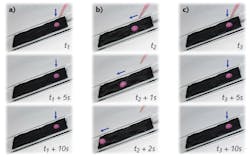Near-infrared light and paraffin enable microfluidics on graphene substrates
Microfluidic systems depend on the controllable movement of liquids or liquid droplets on the surface of a substrate. Unfortunately, such control is not always possible on two-dimensional substrates like graphene. But by using a paraffin-infused porous graphene film (PIPGF) and near-infrared (near-IR) illumination, researchers at Southeast University (Nanjing, China) and Suzhou University of Science and Technology (Suzhou, China) have enabled microfluidics on graphene, and have demonstrated the programmed movement of liquid droplets across a graphene surface.
After fabricating a 300-µm-thick porous honeycombed graphene structure through ionic bonding and acid reduction followed by a freeze-drying process, paraffin wax was liquified to permeate the porous graphene substrate. This PIPGF structure exhibits, at room temperature, strong capillary action that pins liquid droplets to the surface of the graphene. But when 808 nm near-IR light is applied, the wettability of the graphene can be controlled such that surface droplets slide down the substrate when tilted. This process is easily reversed by turning off the illumination and, furthermore, the intensity of near-IR light can control the amount of time before the paraffin is liquified to enable droplet movement. By creating a near-IR mask to control the spatiotemporal wettability of the graphene substrate, microfluidic channels in custom patterns can be created for a variety of applications. Reference: J. Wang et al., Sci. Adv., 4, 9, eaat7392 (Sep. 14, 2018).

Gail Overton | Senior Editor (2004-2020)
Gail has more than 30 years of engineering, marketing, product management, and editorial experience in the photonics and optical communications industry. Before joining the staff at Laser Focus World in 2004, she held many product management and product marketing roles in the fiber-optics industry, most notably at Hughes (El Segundo, CA), GTE Labs (Waltham, MA), Corning (Corning, NY), Photon Kinetics (Beaverton, OR), and Newport Corporation (Irvine, CA). During her marketing career, Gail published articles in WDM Solutions and Sensors magazine and traveled internationally to conduct product and sales training. Gail received her BS degree in physics, with an emphasis in optics, from San Diego State University in San Diego, CA in May 1986.
